Gardening is a high-quality hobby that can be loved day or night time. But, have you ever notion about creating a moon lawn? A moon garden is a special kind of lawn that is designed to be loved within the evening and at night. It capabilities flora which can be aromatic, white or light-colored, and that bloom at night time, making it a perfect spot for a romantic evening walk or rest after an extended day. In this blog publish, we are able to explore 20 enchanting night time-blooming flora so that it will upload a touch of magic for your moon garden. From the sweet fragrance of jasmine to the delicate petals of the moonflower, we will introduce you to loads of beautiful plant life so as to make your garden come alive at night time. So, take hold of a cup of tea, take a seat again, and let’s explore the sector of night-blooming flora.
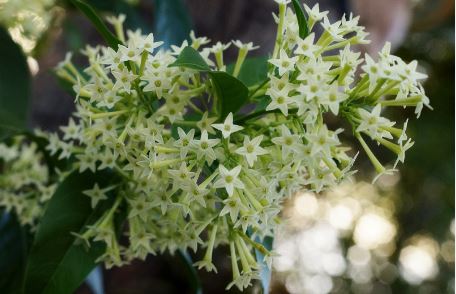
20 Night-Blooming Plants for Your Moon Garden
1. Moonflower (Ipomoea alba)


Often known as tropical white morning glory, this vining perennial is ideal for vertical gardening utilizing a trellis, pergola, or different supportive construction. Blossoming within the late afternoon and lasting solely via the night time, the moonflower’s giant, white flowers related to the moon are heart- or trumpet-formed and provides off a lemon scent.
USDA Hardiness Zones: 10 to 12
Examples of moonflower: Pink moonflower (Ipomoea muricata) and scarlet morning glory (Ipomoea hederifolia)
Care: Low-upkeep, deer-resistant, and drought-tolerant. Moonflower grows in a variety of nicely-drained soils. Moonflower can change into invasive — maintain it in examine by eradicating seed pods earlier than they open.
Blooms: White; nonetheless, purple blooms are additionally out there; flowers in summer season and fall
Perfume: Robust, lemony scent
Value: Get a pack of 25 seeds for about $3.
2. Night Primrose (Oenothera biennis)


A biennial wildflower with furry leaves and yellow flowers, night primrose will come again by itself twice.
Night primrose is a kind of nocturnal crops that draws hummingbirds, butterflies, and different pollinators to your backyard. For hundreds of years, Native People have used this plant for medicinal and meals functions.
USDA Hardiness Zones: 3 to 11
Examples of night primrose: Missouri night primrose (Oenothera macrocarpa) and Lemon Sundown (Oenothera longifolia)
Care: Very low-upkeep and drought-tolerant, night primrose wants little watering. Plant night primrose in full solar and nicely-drained soil.
Blooms: Yellow/golden, some varieties could be pink or white. Night primrose flowers in spring, summer season, and fall.
Perfume: Candy perfume much like an orange
Value: A seed packet can run you near $8.
3. Night-Blooming Jasmine (Cestrum nocturnum)
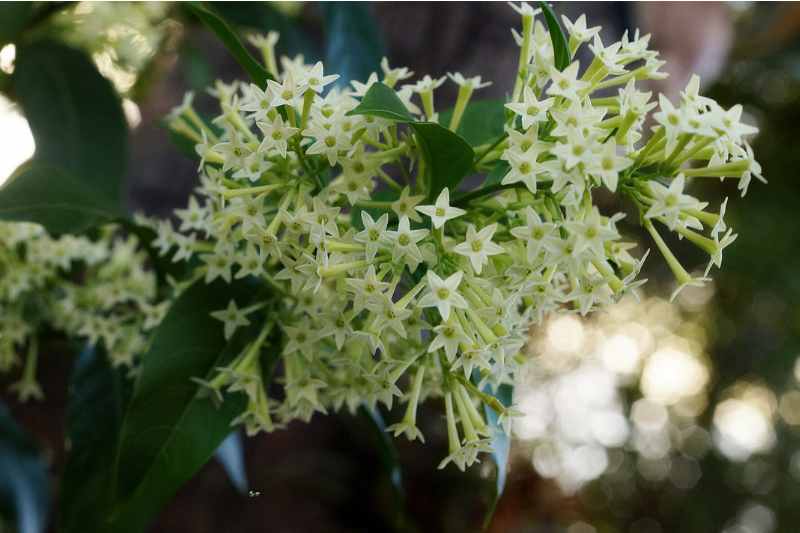

Grown principally for its nice perfume, this broadleaf evergreen shrub requires full solar or partial shade and moist, nicely-drained soil. Evening-blooming jasmine (additionally referred to as night time-blooming jessamine) can develop as much as 10 toes tall, and its columnar form is ideal for planting as a privateness display screen or windbreak.
Aromatic blooms seem on these bushes at night time from January via June.
USDA Hardiness Zones: 8 to 11
Care: Low-upkeep. Prune to form night time-blooming jasmine, water recurrently, and fertilize in summer season each few weeks.
Blooms: Cream, inexperienced, white, yellow, or pink flowers. Evening-blooming jasmine additionally produces purple, white, or pink berries.
Perfume: Very robust, candy scent permeating a number of hundred toes across the plant
Value: Plan to spend round $5 for a potted plant
4. 4 O’Clocks (Mirabilis jalapa)


Per their identify, these flowers are inclined to bloom within the late afternoon, wherever between 4 p.m. and eight p.m. Often known as the Marvel-of-Peru, these deciduous shrubs could be grown as both perennials or annuals, relying on local weather, and can entice hummingbirds and different pollinators. Develop four o’clocks in full solar or half shade.
USDA Hardiness Zones: 9 to 10
Examples of 4 o’clock: Alba, Kaleidoscope, and Jingles
Care: Low-upkeep and proof against drought, illness, and pests. Fertilize 4 o’clocks provided that the leaves flip pale inexperienced.
Blooms: Could be white, copper, purple, yellow, magenta, multicolored, or pink. 4 o’clock blooms are funnel-formed and develop in clusters of 1 to 5 flowers.
Perfume: Candy, refined citrusy perfume
Value: A pack of seeds can price you $5.
5. Tuberose (Polianthes tuberosa)
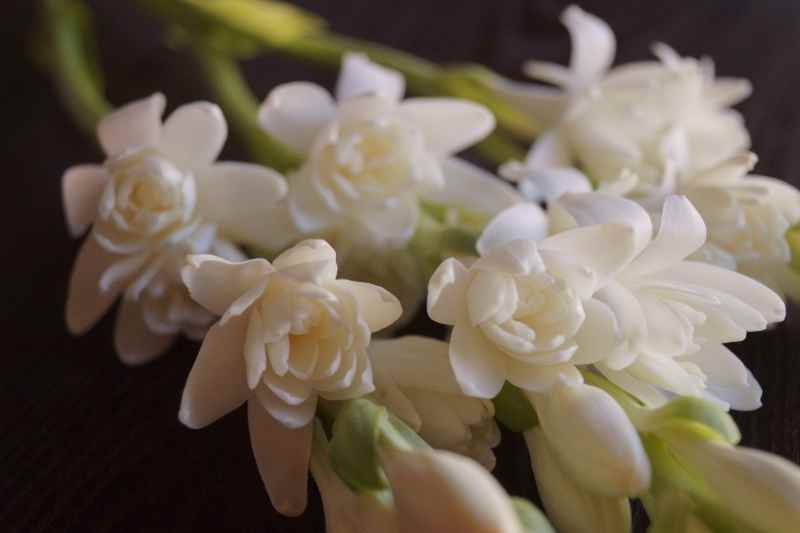

A plant native to Mexico, tuberose is usually utilized in Hawaiian leis and thrives within the warmth of summer season, with nocturnal flowers blooming in August and September. Plant bulbs in full solar and nicely-drained soil, and remember to area them 8 inches aside in 2 toes of soil to accommodate their progress.
USDA Hardiness Zones: 7 to 10
Examples of tuberose: Single Mexican and Double Pearl
Care: Add 3-4 inches of mulch to maintain the soil moist, and use gradual-launch fertilizer firstly of summer season.
Blooms: Giant, white blooms on stems that can attain 3 toes in top
Perfume: Peaches-and-cream-sort aroma with floral notes
Value: You should purchase 10 medium-sized bulbs for about $26.
6. Angel’s Trumpet (Brugmansia)


An herbaceous perennial, angel’s trumpet is a self-pollinating, small tree or giant shrub that can attain as much as 15 toes in top. Plant angel’s trumpet in partial shade, and put together for showy, foot-lengthy, trumpet-formed blooms from spring via fall.
Be aware: These night time backyard crops are toxic and delicate to frost. In winter, contemplate bringing it inside — it additionally does nicely as a houseplant.
USDA Hardiness Zones: 9 to 11
Examples of angel’s trumpet: Betty Marshall, Dawn, Isabella
Care: Low-upkeep; doesn’t require pruning, however doing so in fall can encourage extra new progress. Fertilize weekly and look out for pests, akin to spider mites. It prefers water that’s been disregarded for a day somewhat than contemporary from the faucet.
Blooms: Yellow flowers, in addition to pink, white, apricot, or orange. Angel’s trumpet blooms are available styles of singles, doubles, triples, quadruples, and shredded-wanting blossoms.
Perfume: Generally overpowering. Relying on selection, scents can vary from lemony to minty to musky to citrusy to floral.
Value: Seeds round $10, stay plant round $20
7. Queen of the Evening (Epiphyllum oxypetalum)
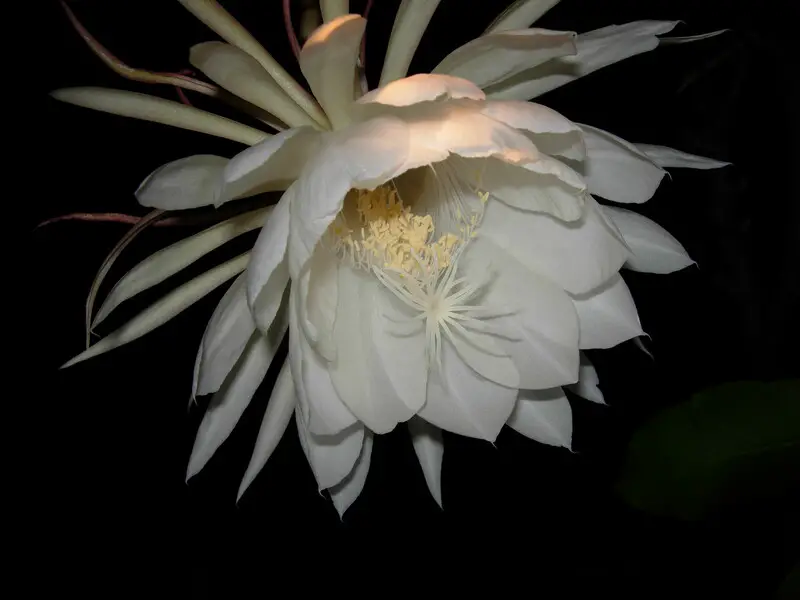

An evening-blooming cereus (or cactus), generally known as an orchid cactus, queen of the night’s giant, white blooms open at nightfall for only one night time per yr, returning to a closed bud type the following morning. Like many succulent crops, this one does greatest in full solar or partial shade and nicely-drained soils and is ideal as a houseplant.
USDA Hardiness Zones: 10 to 12
Care: Low-upkeep. Water queen of the night time month-to-month in winter and produce it indoors to guard it from the chilly. Finest if grown in a container.
Blooms: Giant, enticing, white blooms
Perfume: Candy perfume with floral notes
Value: Get one rooted plant for about $10.
8. Casablanca Lily (Lilium ‘Casa Blanca’)

Praised for its pretty perfume, this hybrid lily is commonly used as lower flowers. Casablanca Lily is straightforward to develop, so long as it’s carried out in full solar or partial shade and nicely-drained soil. It has flowers that open at night time in June and July. Maintain a watch out for pests, akin to lily leaf beetles and aphids, and the lily mosaic virus.
USDA Hardiness Zones: 5 to eight
Care: Low-upkeep and grown from perennial bulbs; mulch to take care of moisture. Plant in nicely-drained soil to keep away from bulb rot. Deadhead blooms after flowering.
Blooms: White blooms
Perfume: Robust, candy scent
Value: A pack of bulbs could be bought for $6.
9. Flowering Tobacco (Nicotiana alata)


Place flowering tobacco close to a window or patio doorway to benefit from the fragrant pleasantries of those night time-blooming crops. Thriving greatest in full solar or partial shade, remember to enable 1 to three toes of area between every plant.
The massive, trumpet-formed blossoms open nightly in summer season and fall, however its buds can nonetheless entice pollinators, akin to butterflies and hummingbirds, throughout the day.
USDA Hardiness Zones: 10 to 11
Examples of flowering tobacco: Child Bella Vintage Pink, Lime Inexperienced, and Saratoga Rose
Care: Water recurrently, as this plant has a low drought tolerance. Plant in spring after the final frost.
Blooms: Pink, purple, inexperienced, pink, white, or yellow flowers, relying on sort
Perfume: Candy perfume, paying homage to jasmine
Value: Get 750 seeds for round $3.
10. Gardenia (Gardenia jasminoides)


A prime decide for corsages and wedding ceremony bouquets, this night time-blooming, evergreen shrub opens its flowers in spring and summer season. Additionally grown as a houseplant, gardenia jasminoides thrives in acidic, nicely-drained soil and areas that obtain full solar or partial shade.
USDA Hardiness Zones: 7 to 11
Examples of gardenia: August Magnificence, Crown Jewel, Fortuniana
Care: Deadhead spent blooms and prune shrubs into the specified form. Water when the soil feels dry (about twice per week). In summer season, fertilize each couple weeks.
Blooms: Varied colours, together with white, cream, and yellow
Perfume: Candy, jasmine-like scent
Value: Anticipate to drop round $40 for a stay, potted plant.
11. Evening Gladiolus (Gladiolus tristis)


Named after the Latin phrase for “sword,” as they boast a protracted, pointed stalk and ostentatious blooms, the night gladiolus is proof against deer and drought and blooms nightly in early spring.
USDA Hardiness Zones: 7 to eight
Care: Plant in full solar and nicely-drained soil. Evening gladiolus doesn’t want a lot water. Permit it loads of area to develop.
Blooms: White or yellow
Perfume: Scent has trace of spice
Value: Spend $4 on a packet of seeds.
12. Evening Phlox (Zaluzianskya)


Excellent for including bursts of coloration among the many principally pale and white blooms typical for night time backyard flowers, night time phlox — aka “midnight candy” — is available in purple, pink, or white colours. A low-rising floor cowl native to South Africa, its buds open at nightfall and emit a lovely aroma.
USDA Hardiness Zones: 9 to 10
Care: Plant in full solar and nicely-drained soil; drought-tolerant however do greatest with common watering. Could be grown in-floor or in containers.
Blooms: Purple, pink, or white
Perfume: A mixture of honey, almond, and vanilla
Value: For about $5, you can get a pack of 1,000 seeds.
13. Chocolate Daisy (Berlandiera lyrata)


As its identify suggests, this wildflower is a plant that blooms at night time and provides off the distinct scent of cocoa every night. When a brand new day dawns, the blooms of this perennial fall to the bottom. Its look is much like a daisy’s; it’s proof against deer and attracts pollinators with its candy nectar.
USDA Hardiness Zones: 4 to 10
Care: Plant in nicely-drained soil. Doesn’t want a lot water, fertilizer, or mulch. Deadhead to encourage new progress.
Blooms: Yellow petals with darkish brown heart; blooms from April via November
Perfume: Emits a chocolate aroma
Value: Get 20 seeds for round $7.
14. Pink Flare Water Lily (Nymphaea ‘Red Flare’)


Excellent for your yard pond or different water options, the tropical ‘Red Flare’ water lily sports activities reddish-purple blooms and maroon-coloured leaves that sit atop the water’s floor. Flowers open nightly from July via October and glow within the moonlight.
USDA Hardiness Zones: 9 to 11
Care: Requires full solar and water temps that attain at the very least 60 levels
Blooms: Pink, pink, or purple
Perfume: Mild scent
Value: Buy a seed packet for round $9.
15. Night Rain Lilies (Zephyranthes drummondii)
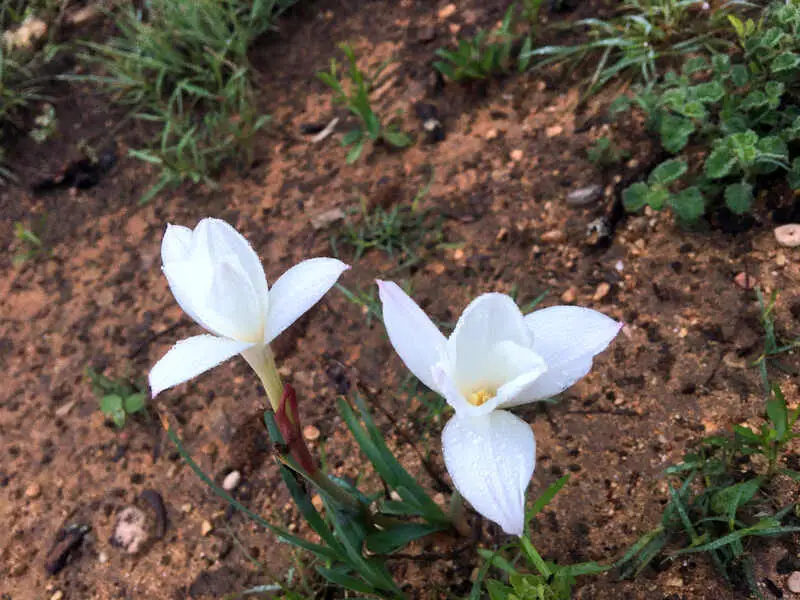

You’ll discover these night time-bloomers open up quickly after a rain, therefore their identify. Preferring full solar however capable of develop in partial shade, evening rain lilies give off smaller blossoms from late summer season to early fall.
USDA Hardiness Zones: 7 to 10
Examples of night rain lily: Fedora (emits bigger blooms)
Care: Low-upkeep, however like a whole lot of night time-blooming crops, it wants a reasonable quantity of water. Plant 6 inches aside to permit room for progress.
Blooms: Pink or white blooms
Perfume: Lilac-like scent
Value: Bulbs can run you about $4 every.
16. Foamflower (Tiarella cordifolia)
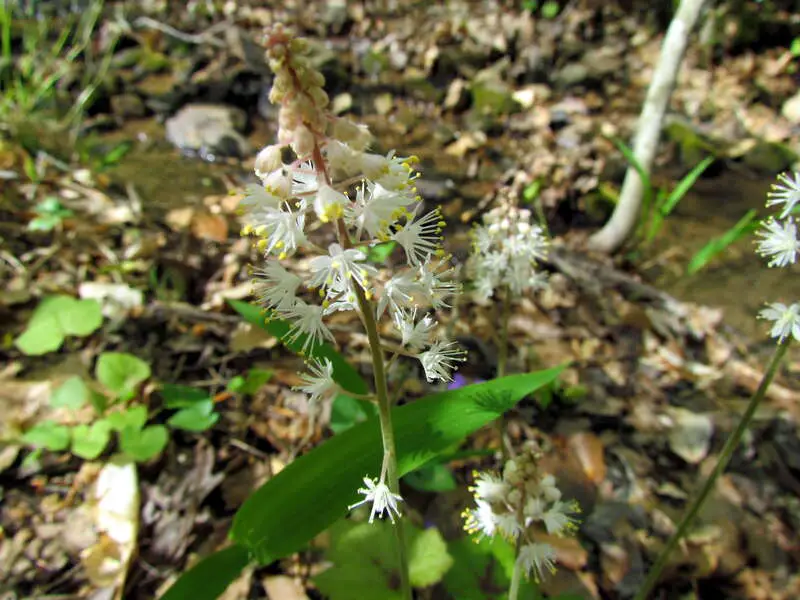

In case your property doesn’t obtain a whole lot of solar, decide to develop foamflowers. These shade-loving, perennial crops work nice as a floor cowl and are proof against deer and rabbits. Named after the Greek phrase for “tiara,” these night time crops sport showy, star-formed flowers, and the general plant spreads rapidly through runners.
USDA Hardiness Zones: 4 to 9
Examples of foamflower: Brandywine, Oakleaf, Sugar and Spice
Care: Low upkeep; maintain the soil moist and deadhead spent blooms. Illnesses and pests aren’t an issue for this plant.
Blooms: Pink or white blooms in early spring via summer season
Perfume: Nice scent
Value: Buy potted for about $7 every.
17. Mock Orange (Philadelphus coronarius)
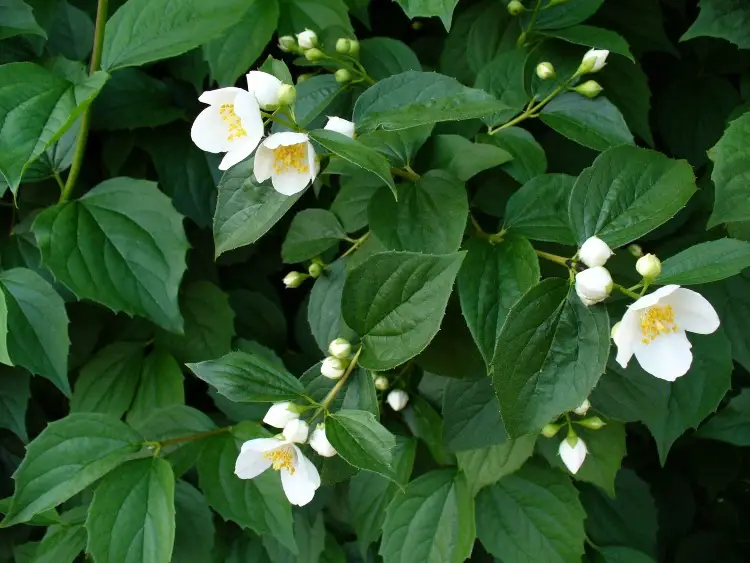

A deciduous shrub that prospers in varied nicely-drained soils, mock orange needs to be in full solar or partial shade. Reaching 10 to 12 toes excessive and broad, this night time-blooming plant works completely as a privateness hedge round your different moon backyard crops.
USDA Hardiness Zones: 4 to eight
Examples of mock orange: Romantic Knight, Aurea, Minnesota Snowflake
Care: Low-upkeep and winter-hardy; water when soil is dry to the contact. Fertilize yearly with compost, somewhat than nitrogen.
Blooms: White blooms in early spring to early summer season
Perfume: Hints of citrus
Value: Buy a 3-foot, stay shrub for round $80.
18. Dame’s Rocket (Hesperis matronalis)


Whereas grown as a biennial, the Dame’s Rocket can final for years due to its self-seeding nature. A lover of full solar or partial shade, this night time-blooming plant can thrive in a variety of nicely-drained soils, is proof against deer, and enticing to nighttime pollinators.
USDA Hardiness Zones: 3 to eight
Care: Low-upkeep; Deadhead spent flowers to encourage new progress and water recurrently. Illnesses and pests aren’t an issue.
Blooms: Purple and white blooms
Perfume: Candy scent likened to a mix of violet and cloves
Value: Buy a considerable amount of seeds for round $12.
19. Night-Scented Stock (Matthiola longipetala)
Characteristics: Night-scented stock is an annual plant recognized for its clusters of small, four-petaled flowers. The plants are generally white or sun shades of purple and crimson. The plant reaches a top of about 12-18 inches.
Fragrance: The fragrance of the night-scented inventory is sweet and highly spiced, making it a popular desire for gardens where the fragrance can be enjoyed during the evening hours.
20. Night-Blooming Cactus (Epiphyllum oxypetalum)
Characteristics: This epiphytic cactus is regularly cultivated for its big, showy, white plant life that bloom at night time. The flowers may be up to 12 inches in diameter and have severa slender petals. The plant itself has flat, segmented stems.
Fragrance: The fragrance of the night-blooming cactus is strong and candy, adding a delightful aroma to the evening air. The blooms are ephemeral, regularly lasting best one night time.
21. Night-Blooming Orchid Cactus (Epiphyllum crenatum)
Characteristics: Similar to the night-blooming cactus, this species of Epiphyllum produces massive, spectacular plants. The blooms can vary in color, inclusive of shades of white, red, and pink. The stems are flat and segmented, and the plant is generally smooth to care for.
Fragrance: The flowers of the night-blooming orchid cactus may be fragrant, and their splendor is better by way of their nocturnal nature.
22. Night-Blooming Cereus (Selenicereus grandiflorus)
Characteristics: Also referred to as “Queen of the Night,” this cactus produces elaborate, white plant life that bloom at night time. The stems are hiking or sprawling, and the flora may be quite big, up to 8-10 inches in diameter.
Fragrance: The fragrance of the night time-blooming cereus is often described as sweet and distinguished. The blooms are a charming sight, and their fragrance adds to the allure of this nocturnal plant.
Choosing the proper region to your moon lawn
Choosing the proper vicinity on your moon lawn is important to ensure the most suitable growth and blooming of your night time-blooming flowers. These magical flowers thrive in particular lighting situations and can create a enthralling ecosystem for your garden during the night hours.
First and foremost, recollect the supply of herbal moonlight within the chosen place. Moonlight is softer and extra diffused than direct daylight, supplying simply the right amount of illumination for these delicate plant life. Ideally, pick a spot that gets at least a few hours of direct moonlight each night time.
In addition to moonlight, be aware of the encircling surroundings. Moon gardens are excellent loved in a tranquil and serene putting, faraway from brilliant streetlights or other sources of artificial mild which could decrease the ethereal splendor of the night time-blooming vegetation. Look for a secluded corner of your garden or create a comfy corner that gives privacy and a feel of tranquility.
Consider the soil excellent and drainage as properly. Night-blooming plants decide upon nicely-draining soil to save you waterlogging and root rot. Amending the soil with natural be counted can enhance its fertility and make sure healthful boom. If your selected region has heavy clay or sandy soil, you can need to make suitable changes through adding compost, peat moss, or sand.
Furthermore, take into account the height and association of nearby flowers and systems. Plant taller flowers or shrubs at the back of the moon lawn to create a natural backdrop that complements the captivating ambiance. This arrangement will even offer shelter and colour to the night-blooming plants at some point of the day, protective them from excessive daylight.
Lastly, don’t forget accessibility and visibility whilst selecting the place for your moon garden. Select a gap that may be easily widespread and accessed, allowing you to fully immerse your self inside the splendor of those nocturnal wonders. Whether it is close to a patio, a sitting region, or a bedroom window, putting your moon lawn wherein it is able to be loved and appreciated will add an extra contact of magic to your out of doors space.
Creating a harmonious moon garden design

Creating a harmonious moon lawn layout is an critical issue of embracing the mesmerizing splendor of night-blooming vegetation. A moon garden have to evoke a experience of tranquility, thriller, and appeal, all even as accentuating the ethereal glow of the moonlight.
To acquire this, begin with the aid of selecting a color palette that enhances the moon’s tender illumination. Opt for light and pastel colorings such as whites, silvers, blues, and purples, for you to beautify the moonlit ambiance. These hues not handiest mirror the moonlight however also create a serene and calming ecosystem.
Consider incorporating plants with distinct heights and textures to feature depth and measurement in your moon garden. Tall, narrow vegetation like Nicotiana alata (flowering tobacco) or Datura metel (angel’s trumpet) can create a vertical focal factor, whilst lower-growing plants like Alyssum or Evening Primrose can fill in the gaps with their sensitive blooms.
Another critical detail of a harmonious moon lawn design is perfume. Night-blooming vegetation regularly emit intoxicating scents, which might be stronger with the aid of the cooler evening air. Include aromatic plant life which includes Jasmine, Night-blooming Cereus, or Honeysuckle to infuse your lawn with delightful aromas a good way to delivery you to a paranormal realm.
To beautify the overall ambiance, strategically place seating areas or cozy nooks where you can loosen up and revel in the moonlit spectacle. Consider incorporating gentle lights, which includes string lighting or lanterns, to feature a hint of attraction and make certain your moon garden remains fascinating even after the solar units.
Other elements to decorate your moon garden
Creating a moon lawn is not pretty much deciding on the proper night time-blooming flowers; it’s also approximately improving the overall revel in for a sincerely enthralling atmosphere. By incorporating different factors into your moon garden, you may create a captivating and immersive environment so as to leave you and your guests in awe.
One element to bear in mind is lighting. Soft, subtle lights can add a paranormal touch in your moon garden. Consider installing solar-powered fairy lights or lanterns that emit a gentle glow, illuminating the pathways and highlighting the splendor of your plant life. Strategic placement of candles or tea lights can also create a romantic and dreamy atmosphere.
Another element to beautify your moon lawn enjoy is sound. The soothing melodies of wind chimes or the gentle trickle of a small water feature can upload a chilled and mystical air of mystery for your lawn. The sound of nature, which includes the chirping of crickets or the rustling of leaves within the breeze, can similarly immerse you within the tranquility of the night time.
Adding cushty seating areas is another way to beautify your moon lawn enjoy. Choose relaxed chairs or benches that invite you to take a seat and relax even as enjoying the sights, sounds, and smells of your garden. Consider placing them strategically near your night-blooming vegetation, permitting you to fully respect their beauty and fragrance.
Care and preservation pointers for night-blooming Plants
Caring for night time-blooming flowers calls for a piece of extra attention as compared to their daylight hours opposite numbers. These precise and fascinating vegetation require precise care and maintenance to make sure their health and splendor in your moon garden.
First and essential, it is important to offer good enough lighting in your night time-blooming plants. While they thrive in the darkish hours, they nonetheless require a few mild at some stage in the day to develop and flourish. Place them in a place that receives partial shade during the day to guard them from the scorching solar. This will enhance their potential to bloom brilliantly at some point of the night.
Watering is another crucial component of preserving night-blooming plant life. These plants usually have shallow roots, so normal watering is important to preserve the soil moist. However, be careful not to overwater, as excessive moisture can result in root rot. A good rule of thumb is to water when the top inch of soil feels dry to touch. Additionally, recall the usage of a nicely-draining soil mix to save you waterlogging.
Fertilizing your night time-blooming plants is critical for selling wholesome boom and considerable blooming. Use a balanced, slow-launch fertilizer particularly formulated for flowering plant life. Apply it consistent with the bundle commands, generally each 4 to 6 weeks at some stage in the developing season. Be careful no longer to over-fertilize, as this may bring about immoderate foliage boom on the expense of blooming.
Pruning is every other issue of care that should not be disregarded. Regularly eliminate spent flowers to encourage the plant to provide new blooms. This can even save you the plant from setting strength into seed production. Additionally, pruning can assist maintain the shape and length of the plant, making sure it remains visually attractive on your moon lawn.
Lastly, take note of pests and diseases that could have an effect on your night time-blooming plant life. Keep a watch out for common garden pests like aphids, snails, and slugs. Use natural pest control strategies or insecticidal soaps to fight those invaders with out harming the delicate flora or the environment. Regularly check out the flora for any symptoms of sicknesses consisting of powdery mold or leaf spot, and take suitable measures to save you their unfold.
The magic of experiencing a moon garden at night
As the sun units and darkness falls, a whole new global awakens in a moon lawn. The magic of experiencing a moon lawn at night is certainly captivating. The air is packed with a subtle fragrance, and the soft glow of moonlight casts a mysterious ambiance over the landscape.
Imagine walking thru a lawn illuminated by the light, silvery mild of the moon. The flora in a moon garden come alive at night time, and their sensitive petals appear to shimmer and dance inside the moon’s airy glow. The night-blooming plants take middle level, their captivating beauty unfolding beneath the starry sky.
One of the most fascinating components of a moon lawn is the play of mild and shadow. The moon casts a gentle, diffused mild that creates an enchanting ecosystem. It highlights the contours of the plants, casting elongated shadows that add depth and intrigue to the lawn.
As you walk via the moon garden, you may note how the colours appear greater muted and diffused. The moonlight has a way of remodeling vibrant colorations into softer, extra sensitive sunglasses. Whites, silvers, and pastels dominate the palette, giving the garden a dreamy, otherworldly quality.
The night time-blooming flora in a moon lawn are a sight to behold. From the stylish Moonflower with its huge, fragrant blooms that unfurl inside the moonlight, to the delicate Evening Primrose that releases its sweet scent as nightfall settles in, every flower brings its very own precise attraction to the nocturnal lawn.
The stillness of the night adds to the magical experience. The rustling of leaves, the chirping of crickets, and the occasional hoot of an owl create a symphony of sounds that immerse you inside the tranquility of the night time. It is a time for reflection, for connecting with nature, and for embracing the splendor that simplest famous itself underneath the moon’s watchful gaze.
Experiencing a moon lawn at night is a honestly awe-inspiring revel in. It lets in you to get away the hustle and bustle of day by day lifestyles and immerse yourself in a world of beauty and serenity. Whether you create your own moon lawn or visit a public garden that embraces the night, be prepared to be captivated by means of the magic that unfolds beneath the moonlit sky.
Benefits of getting a moon garden
Having a moon lawn can offer a large number of blessings that cross past the mere aesthetic enchantment. While traditional gardens are enjoyed throughout the day, a moon lawn provides a completely unique enjoy with the aid of embracing the night and charming the senses underneath the spell binding glow of the moon.
One of the principle blessings of a moon garden is the opportunity to increase the enjoyment of your outside area into the nighttime hours. By incorporating night-blooming flowers and plant life with white or mild-colored blooms, you may create a paranormal environment that comes alive because the solar sets. The gentle, sensitive colorings of these plant life, mixed with the mild illumination of the moon, create a tranquil and romantic atmosphere that is ideal for rest, meditation, or absolutely unwinding after a long day.
Another benefit of getting a moon lawn is the enchantment it brings to nocturnal pollinators. Many night-blooming plants possess intoxicating fragrances that are launched after dark, appearing as nature’s invitation to moths, bats, and other midnight pollinators. By incorporating those flora into your garden, you not simplest provide a habitat for these creatures however also contribute to the general biodiversity of your surroundings.
Moreover, a moon lawn can be a sanctuary for the ones seeking a respite from the hustle and bustle of daylight hours sports. It serves as a peaceful retreat, permitting you to break out the noise and distractions of ordinary life. The serene and airy ecosystem created by using the moonlight and the mild rustle of leaves can sell a feel of calmness and tranquility, providing a space for reflection and rejuvenation.
Additionally, moon gardens can be environmentally friendly. Night-blooming flora frequently require much less water and maintenance in comparison to their daylight hours counterparts. This can help conserve resources and decrease the amount of effort and time required to maintain your garden.
FAQ: Night-Blooming Flowers
Are There Crops That Develop in Moonlight?
Most crops that bloom at night time want full solar to open up their flowers at night time. Nonetheless, when the moon’s mild is at its brightest, mild helps affect plant progress, as nicely. The thought is historic and nonetheless supported by some consultants, together with the Farmers’ Almanac.
What Type of Crops Work in a Moon Garden?
When contemplating crops for your moon backyard, select ones with variegated or shiny, silvery foliage and white or mild-coloured flowers. Embrace flowers that bloom at night time and are illuminated beneath the sunshine of the moon.
Whereas the next don’t bloom at night time, they could be a good addition to the night time-blooming flowers above. Different choices for flowers to finish your moon backyard are:
- Hydrangeas
- Candy alyssum
- Daffodils
- Magnolias
- Petunias
- Peonies
- Shasta daisy
What Are Some Flowers That Characterize The Moon?
In varied cultures and mythologies, totally different flowers have been related to the moon, symbolizing its magnificence, luminosity, and mystical attract. Some flowers associated to the moon embody:
- Moonflower
- Night primrose
- White yarrow
- Evening phlox
- Angel’s trumpet
- White lotus
- Jasmine
